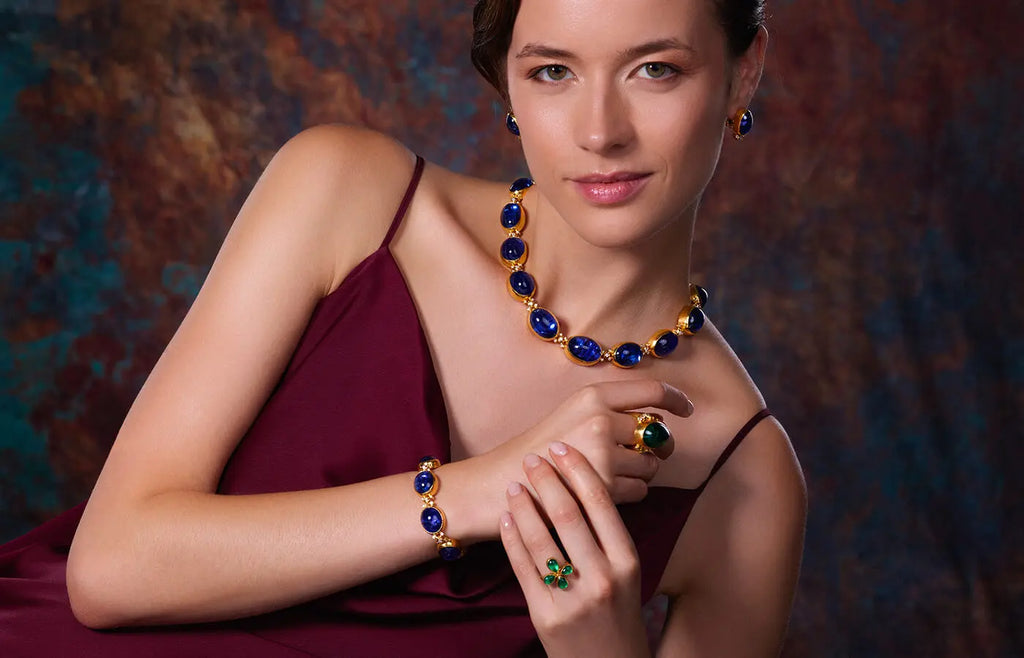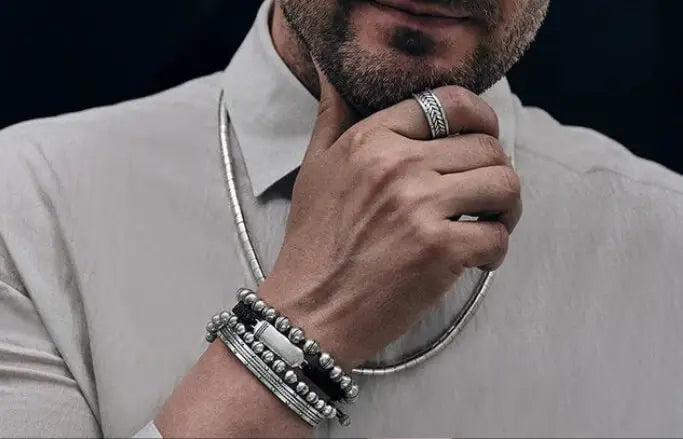Last month, the Opals’ magnificent color-plays focused our attention on change and transformation as October ushered in the falling leaves, reminding us of nature’s own insistence on change.
Now November is here and we’re in the thick of things; our layered garments, steaming teacups, and other seasonal comforts are becoming routine. We have all but forgotten about warm sun and blue beautiful skies as we approach the impending harshness of winter. How fitting, then, that the two November birthstones are Citrine and Topaz—two gemstones celebrated for their simple, vibrant, and warm sun-like hue, and a famed sky-blue color, respectively.

Designated by gem enthusiasts as the “Light Maker,” the Citrine’s quality does just that. It emanates brightness as if it were the fallen residue of beaming rays of sunshine; this brilliant stone inspires optimism, imagination, success, abundance, enthusiasm, enlightenment, happiness, power, and personal will.

Known for possessing “God’s Wisdom,” the Topaz’s shades usually range from a brilliant golden yellow to fiery orange, but can also reach scorching red, pale gray or green, and even—at its rarest—sherry pink or deep blue. Whatever the color, Topaz possesses a very high amount of luster that seems to suggest the stone contains reserves of intense cosmic energy. The Topaz birthstone inspires strength and vibrancy, courage and wisdom, love and friendship with a dose of gentleness and ease of the mind.
What’s The Difference Between Citrine & Topaz?
Despite commonly being misidentified and even wrongly appraised for one another, the Citrine and the Topaz November birthstones are completely different gem species. It can be easy to confuse them because the Topaz’s most common natural color—golden brown to yellow—is similar to that of the Citrine. But the Citrine stone is a Quartz gem—meaning it can be visually identified by a glassy luster and curved shards, as opposed to the smooth basal cleavage of Topaz.
Topaz gems are also much harder than Quartz gems; Topaz gems score an eight on the Mohs scale of hardness and Quartz gems score a seven; this one-point difference means that the Topaz will very easily scratch a Quartz gem while the Quartz will do virtually no damage to the Topaz. The chemical, physical, and optical properties of the Quartz gems and Topaz gems are different and valued differently. But at one point, any gem of the brown, orange, or yellow color range was considered Topaz. This was before the advent of modern gemology as a recognized science in the 1930s. There now exist a variety of tools—including refractometers and presidium gem testers—that can easily tell the difference between these two November birthstones when the naked eye fails to do so.

Citrine: The Healing Stone
Even large Quartz deposits may only contain a very small amount of Citrine. Fortunately, however, natural Citrine may be sourced from many different parts of the world. Brazil is where most Citrine is mined but also Argentina, Nambia, Burma, the Russian Ural Mountains, Spain, Scotland, and Madagascar. In the United States, deposits of Citrine can be found in North Carolina, Colorado, and California.
Types Of Citrine
The Citrine is the rarest of all Quartz stones. Quartz is extremely common and composed of silicon and oxygen, it is only second to feldspar in abundance on Earth’s continental crust. It has a cryptocrystalline structure, meaning that the crystals come in the shape of a hexagon with six sides. A variety of commercial gems are of the Quartz variety including Amethyst, Blue Quartz, Milky Quartz, Rose Quartz, Smokey Quartz, Dumortierite Quartz—and of course, the coveted Citrine. The varieties of Quartz stones have been the most commonly used minerals in the making of birthstone jewelry since antiquity. Most Quartz stones are actually colorless but the gorgeous, sun-kissed hue of the Citrine is the result of impurities due to iron oxidation. Because Citrine is so rare in nature, and yet in constant demand, most commercial stones have to be heat treated from other Quartz stones to create the Citrine color; this is often done right at the mining site. In fact, many experts believe that nature has its own “treatment” process in the creation of natural Citrine by heating Amethyst and Smokey Quart with lava. And because Quartz is such a common mineral, this process makes Citrine relatively affordable whereas otherwise, it may have been all but impossible to own.
There are a few different varieties of Citrine, which are classified as such because of their difference in color; generally, the darker the color of Citrine, the higher it is valued.
- Golden Citrine—Citrine in its most classically recognizable color. This variety of Citrine is a beautiful drop of sunshine added to a well-designed ring, earring, necklace, or bracelet.
- Lemon Citrine—This shade of Citrine, most closely resembles its namesake—the citron fruit; Lemon Citrine tends to go well with pastel colors
- Madeira Citrine—This variety of Citrine gets its name because its color resembles that of the dark-sherry Portugues Madeira wine.
- Palmeira Citrine—Palmeira is a city in South Brazil, for which this variety of Citrine is named; Palmeira Citrine dazzles with a bright amber color.
Citrines In History
Citrine birthstones and Citrine jewelry has a long and important history.
- Aaron, the high priest of the Israelites, wore a breastplate made up of twelve stones designed to ‘determine God’s judgment’ and it is thought that Citrine was one of those stones.
- Romans, and Greeks during the Hellenistic era prized Citrine as a decorative gem for tools and for citrine jewelry.
- Egyptians used them in their magical Talismans
- The popularity of the Citrine stone reached a new height during the 17th Century when Scots were obsessively adorning handles for their daggers and swords with them; there are even records of entire sword handles made only out of Citrine.
- After this period of Scottish use, Citrine production saw a lull with the growing popularity of diamonds and sapphires but resurged closer towards the 19th century.
- Queen Victoria—a hero and champion for a variety of colorful gems—constantly wore Citrine, and as a result, its popularity took hold again, particularly with the Scots, who witnessed the magnificent gem when the Queen visited Balmoral Castle the official Scottish home of the British royal family from that time forward. The Scottish obsession for Citrine resurged and they continued to embellish their kilts and brooches with them.
- The Art Deco, or Style Moderne, era, reached its zenith during the roaring 20s and the Jazz Age of American History. The Citrine was one of the most popular stones of this era and mesmerized beholders in dramatic Citrine jewelry adorning the great celebrities of stage and screen at the time; the Citrine also embellished a great number of clothes, interior designs, and furniture.
- Today, certain celebrities still flaunt Citrine, including Kate Middleton—who is seen as a perfect representative for the November birthstone because of the combination of her extremely affluent status but also down-to-earth personality. Citrine possesses exquisite beauty but is also one of the most affordable stones on the market. Famous actresses, including Kate Winslet and Jessica Chastain, have also been seen adorned with Citrine jewelry.
Citrine Birthstone Powers, Myths, And Legends
Many ancient cultures saw the great resemblance of Citrine to the sun and thus associated it with the ability to reinvigorate life and to cast out the darkness. Men of antiquity used to carry the stone to ward off poisonous snakes, plagues, and evil thoughts. Citrine has a long history of being thought to capture and release negative energy, and to have a calming effect—especially in regard to anger.
- The ancient Egyptians believed the color of the Citrine stone came from the light cast by ‘Ra,’ the ancient Egyptian god of the sun. The Egyptians also associated the Citrine stone with the war goddess Sekhmet as a symbol for sheer power.
- The Citrine stone was very popular among the ancient Romans and Greeks, and the Greeks associated the stone with Demeter, the goddess of harvest—a fitting association for a stone so commonly thought to resemble the sun.
- Ancient Chinese mythology and legend considered the Citrine to be the “success” stone because it had the power to clear fallacies and delusions and to vitalize the intellect.
- This belief among the Chinese still holds strong to this day; it is a Feng Shui belief that if one places a Citrine stone in the designated household area for money and abundance, the stone will help bring wealth and happiness.
- The Chinese also commonly associate the Citrine stone with wisdom, along with success and progress in education.
- Many cultures associated the Citrine stone with success in business and commerce; often nicknamed the “Merchant’s Stone,” the Citrine has enjoyed a reputation for attracting wealth when carried around by salespeople; it is also generally considered to be a stone that brings success in the achievement of personal dreams and ideals by increasing one’s drive, determination, personal will, and the ability to bounce back from failure.
- The Citrine stone can help with good fortune in matters of love by protecting one from the negative energy of envy and heartbreak. The stone might help people in demanding fields from sports to finance by increasing motivation and productivity.
- It can also help high achievers with challenging life goals by increasing the confidence in their ability to achieve those goals.
- A lot of the powers of the Citrine stone are associated with enhancement and a better understanding of the self; therefore keeping a Citrine stone in the room while meditating can help one connect to and process their deepest thoughts and desires.
Caring For Your Citrine Birthstone Jewelry
Citrine is a relatively hard stone but can still be easily damaged by other stones that are above seven points on the Mohs scale; this includes diamonds, sapphire, rubies, and other hard gems.
Citrine can suffer heat damage, including that which comes from prolonged exposure to intense light. Alkaline solutions, hydrofluoric acid, and ammonium fluoride can also damage the stone.
Warm, soapy water is safe to use for cleaning. Due to the possibility of heat damage, steam cleaning is not recommended for the Citrine stone.

Topaz Birthstone
Topaz is made out of silicon, aluminum, and fluorine; it is its own species of mineral that usually forms within the fissures of igneous rocks. The amounts of fluorine necessary to create Topaz are available during the late stages of magma cooling; this is often when Topaz gemstones are formed. Sometimes rocks that have already cooled may have hot, fluorine rich liquids flow through their crevices which allows Topaz gemstones to grow.
At a Mohs hardness rating of eight, it is one of the hardest minerals on earth, and it is the hardest mineral that contains silicon. Its crystals tend to by prismatic and pyramidal; like quartz it is usually clear and transparent or opaque, and is known to come in a variety of colors hence its popularity as a gemstone; unlike quartz, Topaz displays perfectly smooth cleavage similar to that of diamonds; despite its relative hardness (literally, resistance to being scratched—not to be confused with tenacity), because of its cleavage Topaz is rather fragile and easily fragmented—this makes Topaz rather difficult to cut and set.
The color can come from impurities in the stone, but unlike quartz and other gemstones this is not the only way color in a Topaz birthstone is created. Colored centers in a Topaz crystal can be produced by a gap or extra electron in the crystal structure which absorbs certain parts of the light shining into the crystal, producing a range of various colors. Topaz is also pleochroic, which means its color can change when viewed from different angles. Many Topaz varieties—especially blue and pink Topaz—are very rare in nature and so most of the commercial gems are heat-treated to produce the desired color.
Most cuts of Topaz are faceted (cut into sides) and Topaz is very rarely cut into cabochons (polished and round gems) due to the high level of difficulty, but GURHAN—a maverick in topaz jewelry and our other birthstone jewelry designs—has a variety of cabochon Topaz set into many one-of-a-kind 24k gold rings, earrings, necklaces, and bracelets.
Where Topaz Comes From
Most Topaz is sourced from Brazil. A large Topaz deposit was first discovered in Minas Gerais, Brazil in the early-to-mid 18th century—during which Brazil was a colony of Portugal; the Portuguese royal government officially recognized the reserves at Minas Gerais as an important commercial mine and Topaz gemstones began being transported to Europe; to this day Brazil produces more Topaz than any other country. Some of the world’s largest gems are Topaz and several of them were discovered in Minas Gerais, Brazil.
Different Types Of Topaz
Blue Topaz is the most sought-after type of Topaz and this variety is extremely rare in nature. In fact, most Blue Topaz on the market is heat-treated to produce the very desirable deep blue color. The three most common blue tones are Sky Blue, Swiss Blue, and London Blue:
- Sky Blue is pale and gentle in color.
- Swiss Blue Topaz is of brighter more intense blue.
- London Topaz is the darker, steely, grayish variety of Blue Topaz.
Imperial Topaz - also known as “precious” Topaz - is its most valuable form; it’s color rivals that of the setting sun and can come in a combination of orange, yellow, brown, and pinkish hues, and because it resembles the color of sherry is sometimes called Sherry Topaz.
Silver or White Topaz is clear or colorless and depending on the cut of the stone can very closely resemble diamonds. One historical case of misidentified Topaz occurred in 1740; a 1,680 carat gemstone, known as the “Braganza Diamond” was discovered in Minas Gerais, Brazil and encrusted into the Portuguese crown because it was thought to be the largest diamond discovered at the time, but it was later discovered that the gem was not diamond but in fact clear Topaz; it is still part of the Portuguese Crown Jewel Collection.
It’s important to note that some so-called Topaz colors are really not natural: Mystic and Azotic Topaz have a rainbow-like color effect which is exclusively created through artificial treatment and is not for fine jewelry.

Famous Topaz Stones
The largest faceted gemstone in the world is a Topaz, the “El-Dorado Topaz.” The uncut, rough stone was discovered in 1984 in Minas Gerais, Brazil and weighed a whopping 37 kg. After the stone was cut, and the non-gem material eliminated, 6.2kg of the original stone—about 16 percent— was left; the remaining gemstone sits at 31,000 carats with a perfect emerald cut and a beautiful yellowish-brown color and exceptional clarity and transparency. The “El-Dorado Topaz” is held at the Special Exhibitions Gem Collection of the Programa Royal Collections Group in Madrid, Spain.
Topaz Birthstone History, Myths, Powers, And Legends
No stranger to mistaken identity, Topaz received its name from the Romans after their discovery of gems on a small island in the Red Sea with the Greek name “Topazios.” But in fact, explorers mistook a soft green hue for the bright yellow of Topaz; the actual gem discovered on the island of “Topazios” was Peridot. Other records indicate the name Topaz may have originated from an ancient Sanskrit word that implied “fire.” Whatever its origin, the Topaz is historically a highly valued, though often misunderstood, gemstone.
Topaz is associated with knowledge and divine wisdom, which may be the reason why it is a good candidate for Biblical significance. Because of this long history of misidentification, much of the history, myths, legends, and powers of other stones are attributed to Topaz, not the least of which would be those of Citrine.
This should not deter one from seeking out Topaz, because the powers of gems do often overlap due to varying similarities in color and texture. And real Topaz has always been valued throughout the ages; 500 of these delicate gems encrust the royal crown of England alone.
- Like Citrine, the golden glow of the ancient Egyptian sun god, Ra, is also attributed to Topaz
- There seems to be a strong association of Topaz with solar energy because the Greeks also connected Topaz with their sun god Apollo. Topaz was also meant to protect against harm and to produce clarity of thought and increased strength.
- One curious ancient belief popular in several cultures was that Topaz gems changed color to warn the wearer that they were about to eat poisoned food or drink.
- Topaz is also associated with increased creativity because of its ability to help the wearer with the clarity of mind necessary to notice intricate details while also being aware of the larger picture.
- Topaz is also considered to be a tool in aiding negative events and emotional trauma, by inspiring a person with the will to make the best out of a difficult situation.
- It is also considered to motivate a person to achieve their goals.
- Blue Topaz is associated with increased clarity of communication and emotional direction, which can certainly aid a person’s love life and help them form deeper relationships and better friendships.
- It may also help to relieve tension in the wearer and quell anger when it arises, leading wearers to a more gentle and joyful disposition.
It is fitting that the Topaz is a stone associated with self-realization and the confidence to approach the world with an independent mindset, because perhaps the most important lesson we can learn from Topazes’ story of conflated beliefs and misidentification is not that belief in the power of this or any gemstone can or should be discarded, but that the true power of gemstones lies not in what they can do for us, but what they can inspire us to do for ourselves. How wonderful it would be to allow the strengthening power of the Topaz to motivate us into achieving our wildest dreams.
Caring For Your Topaz Jewelry
Even though Topaz is hard, its structure makes it rather delicate, so cutting, polishing, and setting it requires extra care. Sharp temperature changes, extreme pressure, or a hard blow might split a Topaz stone. Prolonged exposure to heat or sunlight may also cause the stone’s color to fade. It takes a master jeweler to safely set the stone.
Warm, soapy water is best for cleaning; avoid steam or ultrasound cleaners.
Wearing Topaz Jewelry
The Topaz will inspire anyone to move through the world as a pure individual, free of influences that do not align with their truest desires. Will, adventure, and an independent spirit are very powerful themes behind the GURHAN story and are the perfect energy for cutting and designing the perfect Topaz jewelry.
Despite a history of being misunderstood, the Topaz is a great metaphor for how truly understanding oneself and others unlocks the potential for greatness beyond one’s previously held beliefs or imagination. So, this month, gift yourself or a loved a beautiful Topaz and allow it and its story to inspire you to truly know yourself and take hold of your life and achieve things beyond your wildest dreams.
Shop stunning citrine and topaz Jewelry HERE




